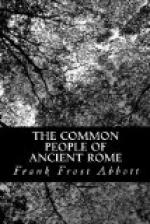In Fig. I the heavy-lined ellipse represents the formal diction of Cicero, the dotted line ellipse his conversational vocabulary. They overlap each other through a great part of their extent, but there are certain literary locutions which would rarely be used by him in conversation, and certain colloquial words and phrases which he would not use in formal writing. Therefore the two ellipses would not be coterminous. In Fig. II the heavy ellipse has the same meaning as in Fig. I, while the space enclosed by the dotted line represents the vocabulary of an uneducated Roman, which would be much smaller than that of Cicero and would show a greater degree of difference from the literary vocabulary than Cicero’s conversational stock of words does. The relation of the uncultivated Roman’s conversational vocabulary to that of Cicero is illustrated in Fig. III, while Fig. IV shows how the Latin of the average man in Rome would compare, for instance, with that of a resident of Lugudunum, in Gaul.
This naturally brings us to consider the historical relations of literary and colloquial Latin. In explaining them it has often been assumed that colloquial Latin is a degenerate form of literary Latin, or that the latter is a refined type of the former. Both these theories are equally false. Neither is derived from the other. The true state of the case has never been better put than by Schuchardt, who says: “Vulgar Latin stands with reference to formal Latin in no derivative relation, in no paternal relation, but they stand side by side. It is true that vulgar Latin came from a Latin with fuller and freer forms, but it did not come from formal Latin. It is true that formal Latin came from a Latin of a more popular and a cruder character, but it did not come from vulgar Latin. In the original speech of the people, preliterary Latin (the prisca Latinitas), is to be found the origin of both; they were twin brothers.”
Of this preliterary Latin we have no record. The best we can do is to infer what its characteristics were from the earliest fragments of the language which have come down to us, from the laws of the Twelve Tables, for instance, from the religious and legal formulae preserved to us by Varro, Cicero, Livy, and others, from proverbs and popular sayings. It would take us too far afield to analyze these documents here, but it may be observed that we notice in them, among other characteristics, an indifference to strict grammatical structure, not that subordination of clauses to a main clause which comes only from an appreciation of the logical relation of ideas to one another, but a co-ordination of clauses, the heaping up of synonymous words, a tendency to use the analytical rather than the synthetical form of expression, and a lack of fixity in the forms of words and in inflectional endings. To illustrate some of these traits in a single example, an early law reads “if [he] shall have committed a theft by night, if [he] shall have killed him, let




